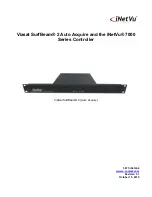
5
Figure 2
The left part of Figure 2 shows such a situation: one GPS sends data to four devices.
It gets complicated when several talkers must send data to one listener (the PC) as shown in the right
part of Figure 2. Unless that listener has multiple inputs, this is not possible without help.
Simply connecting multiple talkers to one listener as shown is like four people simultaneously telling you
a different story. You can make neither head nor tail of it. In electronics terms: the outputs of the talkers
will short-circuit each other and the sentences they transmit will be corrupted.
This is where a multiplexer offers the solution.
The Multiplexer
A multiplexer, sometimes called combiner, has multiple listener
ports, each acting as a listener connected to a single talker. It also
has at least one talker port that outputs the combined data from
the inputs to a listener. So what seemed impossible in Figure 2 is
possible when a multiplexer is added as shown in Figure 3. The
multiplexer listens to the instruments by storing the received
NMEA sentences into queues simultaneously. At the same time it
retrieves the sentences from the queues sequentially and sends
them to the PC.
Since a PC can do so much more than just displaying the
combined data, it soon became apparent that a multiplexer needs
more than just a few inputs and one output. The single talker port
that connects to the PC became a host port, being input and
output at the same time. A few extra talker ports made it possible
to send data to other devices and to drive an autopilot.
The Host
NMEA 0183 devices already existed before it was common practice to use a computer for navigation. Of
course there were ECDIS systems (Electronic Charting and DISplay) but these were used only on
commercial ships. Nowadays it is very common to use a computer, a laptop or a tablet as a charting
device while the navigation software sends information to an autopilot in order to automatically follow a
programmed route. The PC becomes a host and what used to be a talker port on the multiplexer is now
called a host port. The multiplexer becomes the central interface that listens and talks to all navigation
instruments and devices.
Throughout this manual, the common term host is used for a PC, laptop, smartphone, PDA, tablet or any
device that is connected to the multiplexer to receive the combined NMEA data for processing and
display.
The host interface or host port is the interface that connects to these devices and this can be an RS-232,
USB, Ethernet, WiFi or Bluetooth interface.
GPS
PC
VHF
Radar
Auto-
pilot
PC
GPS
Depth
Wind
Log
PC
GPS
Depth
Wind
Log
Multiplexer
Figure 3






































